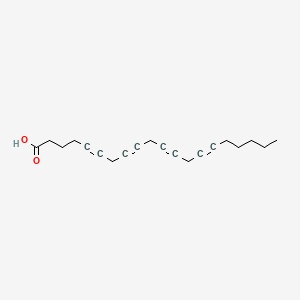| Zenser TV et al. |
Metabolism of N-[4-(5-nitro-2-furyl)-2-thiazolyl]formamide by prostaglandin endoperoxide synthetase. |
1980 |
Cancer Res. |
pmid:6765914
|
| Stuart MJ et al. |
The influence of albumin and calcium on human platelet arachidonic acid metabolism. |
1980 |
Blood |
pmid:6766753
|
| Coceani F and Olley PM |
Role of prostaglandins, prostacyclin, and thromboxanes in the control of prenatal patency and postnatal closure of the ductus arteriosus. |
1980 |
Semin. Perinatol. |
pmid:6990501
|
| Hidaka T et al. |
Metabolism of [14C] arachidonic acid in the isolated rabbit spleen. |
1980 |
Prostaglandins |
pmid:7422893
|
| Lerner U |
Indomethacin inhibits bone resorption and lysosomal enzyme release from bone in organ culture. |
1980 |
Scand. J. Rheumatol. |
pmid:7455622
|
| Weber PC et al. |
Possible significance of renal prostaglandins for renin release and blood pressure control. |
1980 |
Adv Prostaglandin Thromboxane Res |
pmid:6989178
|
| Wertz PW and Mueller GC |
Inhibition of 12-O-tetradecanoylphorbol-13-acetate-accelerated phospholipid metabolism by 5,8,11,14-eicosatetraynoic acid. |
1980 |
Cancer Res. |
pmid:7008936
|
| Conn PM et al. |
An inhibitor of arachidonic acid metabolism stimulates luteinizing hormone (LH) release from cultured pituitary cells. |
1980 |
Prostaglandins |
pmid:6770421
|
| Nemeth EF and Douglas WW |
Differential inhibitory effects of the arachidonic acid analog ETYA on rat mast cell exocytosis evoked by secretagogues utilizing cellular or extracellular calcium. |
1980 |
Eur. J. Pharmacol. |
pmid:6161012
|
| Marks F and Fürstenberger G |
Effect of phorbol ester application and other mitogenic treatments on 3',5'-cyclic-nucleotide phosphodiesterase activity in mouse epidermis in vivo. |
1980 |
Hoppe-Seyler's Z. Physiol. Chem. |
pmid:6256278
|
| Falkenhein SF et al. |
Effect of the 5-hydroperoxide of eicosatetraenoic acid and inhibitors of the lipoxygenase pathway on the formation of slow reacting substance by rat basophilic leukemia cells; direct evidence that slow reacting substance is a product of the lipoxygenase pathway. |
1980 |
J. Immunol. |
pmid:6103910
|
| Watanabe-Kohno S and Parker CW |
Role of arachidonic acid in the biosynthesis of slow reacting substance of anaphylaxis (SRS-A) from sensitized guinea pig lung fragments: evidence that SRS-A is very similar or identical structurally to nonimmunologically induced forms of SRS. |
1980 |
J. Immunol. |
pmid:6104681
|
| Spies C et al. |
Inhibitory effects of mepacrine and eicosatetraynoic acid on cyclic GMP elevations caused by calcium and hormonal factors in rat ductus deferens. |
1980 |
Naunyn Schmiedebergs Arch. Pharmacol. |
pmid:6245377
|
| Smolen JE and Weissmann G |
Effects of indomethacin, 5,8,11,14-eicosatetraynoic acid, and p-bromophenacyl bromide on lysosomal enzyme release and superoxide anion generation by human polymorphonuclear leukocytes. |
1980 |
Biochem. Pharmacol. |
pmid:6245654
|
| Smolen JE and Weissmann G |
Lysosomal enzyme release from human granulocytes is inhibited by indomethacin, ETYA, and BPB. |
1980 |
Adv Prostaglandin Thromboxane Res |
pmid:6246788
|
| Boeynaems JM et al. |
In vitro effects of arachidonic acid and of inhibitors of its metabolism on the dog thyroid gland. |
1980 |
Prostaglandins |
pmid:6247748
|
| O'Flaherty JT |
Involvement of bivalent cations and arachidonic acid in neutrophil aggregation. |
1980 |
Inflammation |
pmid:6771213
|
| Goetzl EJ |
A role for endogenous mono-hydroxy-eicosatetraenoic acids (HETEs) in the regulation of human neutrophil migration. |
1980 |
Immunology |
pmid:6776039
|
| Lazar JD and Whorton AR |
Prostaglandin mediation of potassium effects on renin release. |
1980 |
Life Sci. |
pmid:6777616
|
| Patterson R and Harris KE |
An inhibitor of the lipoxygenase and cyclooxygenase pathways of arachidonic acid, 5, 8, 11, 14-eicosatetraynoic acid, inhibits immunoglobulin E mediated antigen induced monkey asthma and skin reactions. |
1980 |
Trans. Assoc. Am. Physicians |
pmid:6787776
|
